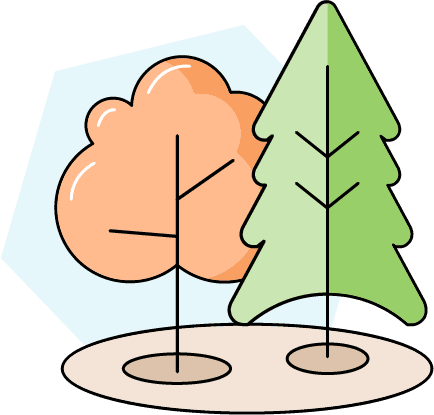If a healthy tree from your neighbor’s property falls in your yard, the general rule is that you are liable for tree removal and damage repair, and your homeowners insurance may help shoulder the cost if the cause was a peril covered in your policy. However, if the tree fell due to a known sickness or a maintenance-related issue, your neighbor would be liable for the damage.
It’s also important to note that homeowners insurance will only cover such costs if the fallen tree damages a covered structure or blocks the driveway. If the tree does not damage anything, homeowners insurance will not foot the bill for any expenses.
Table of Contents
Does Homeowners Insurance Cover Your Tree Falling on a Neighbor’s House?
Yes. If your tree falls on a neighbor’s house due to a covered peril, or vice versa, either your homeowners insurance policy or theirs will help pay for debris removal and damage repair. Homeowners insurance is made up of dwelling coverage and liability coverage, and both may cover tree-related scenarios.

How Dwelling Coverage Covers Fallen Trees
Dwelling coverage, a component of homeowners insurance, protects the structure of your home against certain perils, like fire, wind, hail, or lightning. If your neighbor’s tree falls on your property due to such a peril and through no fault of their own, your dwelling coverage comes into play. It may pay to replace, rebuild, or repair your property’s physical structure, including the removal of the fallen tree. Most policies limit coverage for tree removal around $500 and $1,000.
When you file a claim with your insurance company, you typically must pay a deductible before your policy kicks in. However, your insurer may attempt to collect from the neighbor’s insurance company in a process called subrogation so that you can get reimbursed for your deductible.
How Liability Coverage Covers Fallen Trees
Liability coverage in homeowners insurance protects against personal liability for injuries or property damage to others. If a tree from your property falls on a neighbor’s house, or vice versa, due to a known sickness or maintenance-related issue, liability coverage may cover the associated damages and legal costs.
For example, if your neighbor’s tree was dying or diseased and they knew about it, they could be liable if it topples over. If you sue them for the losses, their liability coverage may kick in to cover the cost of defending them in court and any court awards.
Most liability coverage limits typically start at around $100,000.
Factors Determining Responsibility in the Event of a Fallen Tree
Below are several examples to help determine responsibility of a fallen tree and whether insurance will cover it
Owner of Tree | Location of Tree Fall | Cause of Tree Fall | Damage to Property or Blocking Driveway? | Who is Liable? | Will Insurance Cover It? |
|---|---|---|---|---|---|
You | Your neighbor’s yard | Covered peril | Yes | Determined between parties | Most likely |
You | Your neighbor’s yard | Covered peril | No | Determined between parties | No |
You | Your neighbor’s yard | Negligence or accident | Yes | You | Most likely |
You | Your neighbor’s yard | Negligence or accident | No | You | No |
Your neighbor | Your yard | Covered peril | Yes | Determined between parties | Most likely |
Your neighbor | Your yard | Covered peril | No | Determined between parties | No |
Your neighbor | Your yard | Negligence or accident | Yes | Your neighbor | Most likely |
Your neighbor | Your yard | Negligence or accident | No | Your neighbor | No |
Who’s liable in the event of a fallen tree comes down to three factors:
- Who owns the tree: If the event is due to negligence, who owns the tree is a key factor in removal and repair responsibility. If the event is due to natural causes, who owns the tree is not as important and responsibility can be determined between you and your neighbor.
- Whether there was negligence: If there was prior knowledge of a sickness or damage in the tree, or the tree was damaged during improper maintenance, this could be considered negligence.
- Where the tree fell: If a tree falls across a driveway or onto a piece of property and damages it, homeowners insurance will help cover costs. If a tree falls and does not cause damage or block a driveway, homeowners insurance will generally not help cover costs.
How to Identify and Handle Hazardous Trees

Hazardous trees can collapse at any time. By proactively inspecting your tree, you can significantly lower the risk of it falling over and damaging properties or people.
- Regular visual inspection: Some of the most obvious hazards to watch for in trees include broken or hanging limbs, holes or cracks in the tree trunk, wilting or undersized leaves, and a tree trunk that leans to one side.
- Consult an arborist: Spotting a dangerous tree requires knowledge of the telltale signs. If you’re unsure whether your tree may be hazardous, consult a certified arborist. Arborists can regularly inspect your trees for decay, disease, or structural issues.
- Prune dying/dead branches: Dead and dying branches can become brittle and prone to breaking, which can be especially dangerous during storms or high winds. Each type of tree is different and may have its own pruning standards, so you should consult an arborist before cutting.
- Tree cabling and bracing: Tree cabling and bracing are used to help support the structural integrity of a tree. Arborists may recommend this method if your tree has weak limbs or trunk deficiency.
- Tree removal: Sometimes, pruning dead branches and cabling may not be enough to revive a compromised tree. If your tree suffers from severe internal decay or significant damage to the main trunk, your arborist may suggest removing the tree entirely for safety reasons.
What To Do When a Tree Falls
Here’s what to do if a tree unexpectedly falls on your or your neighbor’s property due to a storm, accident, or other reasons.
- Ensure safety. Before dealing with the collapsed tree, ensure everyone’s safe and unharmed. If anyone is injured, seek immediate medical attention.
- Communicate with your neighbors. If the tree fell on your neighbor’s property or vice versa, you’ll need to communicate with each other to discuss plans for resolution.
- Determine liability. Communicate with your neighbor to understand whether the tree fall resulted from a natural event or potential negligence. Insurance companies are typically responsible for taking care of the damages if the tree fall was an act of nature. But insurers may not foot the bill if it was due to you or your neighbor’s negligence.
- Offer assistance. If your tree falls on your neighbor’s property, offer to assist in cleanup even if it was not due to your negligence. Demonstrating common decency is not only the right thing to do, but it also eases the burden on your neighbor.
- Document the situation. Remember to document the incident with photographs and notes detailing the extent of the damage. This information could come in handy when filing insurance claims and any potential disputes.
- Notify your insurance company. Contact your insurance company to report the incident and initiate the claims process.
- Arrange for professional tree removal. Removing a fallen tree yourself to save money could potentially cause more damage and injuries. So, whether your homeowners insurance policy covers it or not, work with a professional so that the tree is removed safely.
Putting It All Together
While most homeowners insurance policies cover tree-related damage due to a covered peril, things may not be so straightforward if the tree fall resulted from your or your neighbor’s negligence. So, if you have not already, schedule a tree inspection with a certified arborist to ensure your trees do not pose a risk to your neighborhood.
By performing regular maintenance and keeping your trees healthy, you not only prevent potential financial headaches and problems with your neighbor but also keep your own home safe.
